
The uptake of Danielle D'Souza Gill: Platform matters
In this article, which is part of a larger inquiry into the far-right influencer Danielle D’Souza Gill, we discover that the forms of engagement with said public persona's content vary per platform. On Twitter, we see rather shallow forms of engagement, while on Facebook we see a form of micro-hegemony building. Lastly, on Instagram, we see a similar situation to Facebook, but with a heightened personalization aspect.
As the daughter of Dinesh D'Souza, an Indian-American conservative commentator and author known for the controversial film 2000 Mules, Gill has been a vocal supporter of former US President Donald Trump. She is also active as an influencer on Twitter, Facebook, and Instagram. She uses these platforms to express her political and personal thoughts on a variety of topics, as you can read in another article that is part of our project.
These three platforms that Gill uses have wildly varying affordances and limitations (Maly, 2020; Van Dijck, 2013). Twitter only allows short texts, while Facebook and Instagram allow the sharing of longer-form content. Instagram is also known to be a more personalized platform (Poulakidakos & Giannouli, 2019; Van Dijck, 2013). How is this reflected in the uptake of her content? In this article, we analyze the differences in uptake between these three platforms for Gill’s content. By analyzing this we hope to build an understanding of how far-right micro-hegemony is built to better understand the current emergence of this controversial ideology.
More information on Danielle D'Souza Gill can be read here
Methodology and Methods
The methodology that gives foundation to our study is Digital ethnography (Varis, 2015). This means that for epistemological reasons context in the form of a chronotope is treated as an essential factor in meaning-making. To understand the data that we collected in their context Van Dijck's (2013) book Culture of Connectivity was consulted. This book addresses the limitation, affordances, and media ideologies of various socio-technological platforms including the ones our data was collected from. These are reported by van Dijck to be a relevant factor in meaning-making as they make platforms into mediators rather than neutral intermediaries. These factors are made salient in the analysis of data.
These limitations and affordances make platforms into mediators than neutral intermediaries
In order to analyze the uptake of Gill's content on Twitter, Facebook, and Instagram, we utilized the method of discourse analysis (Blommaert, 2005). Discourse data was gathered by screenshotting the comment sections of Gill's posts on social media. Such posts were subjected to in-depth analysis. This was predated and co-occurred with a gathering of Gill's Facebook posts during October 2022. This was turned into a descriptive piechart noting the number of different types of posts in this month. Moreover, based on experience in collecting said data, full comment sections of individual more recent Facebook, Instagram, and Twitter posts were gathered and analyzed in the months of December 2022 and January 2023. These were analyzed by focusing on non-literal meaning in the form of indexicality.
In addition to this, it was attempted to gain contact with individual users to perform an interview with them. We sent Facebook messages to dozens of Gill's followers stating our goal of understanding Gill's follower base better. Such attempts failed as no positive responses were obtained. Either no responses or responses in the negative were noted for all invited. This means it becomes more difficult for us how uptake and engagement with Gill's pages work on a personal level. The individual states of mind of users hence fall outside of the scope of this paper.
A final methodological choice we made was to turn this article into a comparative report between three different platforms. The results of a discourse analysis of comments on all three sites are compared by noting their similarities and differences. Herein specific attention is paid to how such findings might link to the limitations, affordances, and media ideologies associated with particular platforms. This was done to obtain a large variety of data which should aid the reliability as well as the validity of this study (Vogt et al, 2012). Moreover, this comparative approach allows us to get a wider overview of how Gill's engagement works.
The specific platforms were selected because they are rather mainstream. This should help up gain an understanding of what types of engagement with Gill take place early within a user's followership of Gill. By doing so we hope to learn how such users enter into the far-right social group. Researching how this is continued on more niche platforms falls outside of the scope of this study. Each platform was assigned to a singular researcher who would focus on that platform. This allows them to gain a deeper understanding of Gill's uptake there, which allows for optimized data collection and analysis.
Danielle D'Souza Gill's Twitter
Before we can analyze Gill’s tweets we must first note that she barely tweets herself and mainly retweets. Even though these are not her own words, such expressions still index relevant information. To analyze the uptake of Danielle’s tweets we looked at the comments that they prompted.
In this, we found that the majority of responses are concise and to the point. Users reply with one or two sentences. This presumably relates to the affordances and limitations (Maly, 2020) of Twitter such as its strict word limit. Secondly, the accounts that respond to Gill’s tweets do not interact with one another. No interaction occurs between commenters.
The majority of responses are concise and to the point
Moreover, comments can be separated into three distinct categories. Firstly, there are those comments that state complete agreement with Gill’s tweets. These tend to take the form of short one-word phrases such as “agreed!!” or an emoji with a “100” sign as can be seen below in Figure 1. The users behind these comments do not discuss what Danielle is saying, however, they do show their support for her. Such remarks enable Gill's posts to look like deep truths that few users are consciously aware of.

The second category of comments is statements of disagreement regarding the tweet. Such statements are mainly executed through memes. They utilize humor to portray anger and/or disagreement. It can thus be noted that as few words as possible are used in such comments. Many of the comments under Gill’s tweets do not contain any literal text, but merely a meme that serves the same purpose as a literal text would. Given Twitter’s affordances, this makes some sense (Van Dijck, 2013).
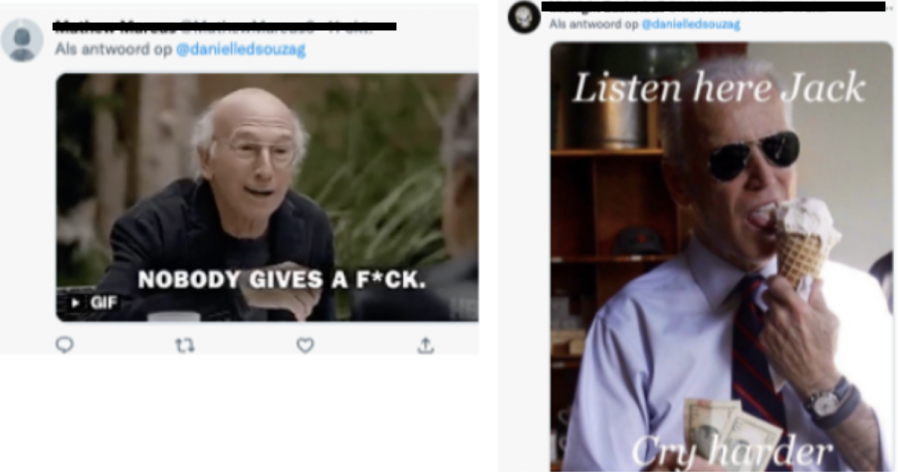
The final category of comments, which is also the smallest by far, are inquisitive comments that seek more information. A handful of replies in the comment section do not agree or disagree with Gill but pose questions and ask for more information about the topic of the initial tweet or retweet.
In this all it was noted that on Gill’s Twitter, content does not clearly impact the type of comments that are prompted. For example, for all posts that were analyzed, we found a roughly equal amount of statements of disagreement, agreement, and inquisitive comments.
Moreover, outside of the last category of comments, most responses to Gill's post do not engage with the original post overtly, except for stating plain agreement or disagreement. For instance, most hate comments left on Danielle’s tweets attack her father and accuse him of being a criminal as he served time in jail, even if the topic of the original tweet was not related to him in any way. This shows a distinct lack of deep engagement with the original post.
Moreover, Gill does not interact much with followers on Twitter. She rarely if ever responds to comments or other possible prompts on Twitter. This deviates from the norm since influencers often use their platforms to interact and bond with their followers to a higher extent (Geyser, 2023). This research will now go on to explore if the same behavior from Gill can also be found on the platforms Facebook and Instagram.

Danielle D'Souza Gill's Facebook
On Facebook, we see a quite different story. However, before analyzing how this is so we must first address one notable factor regarding Gill's Facebook page. The account is run by six people. We were unable to find their identity. However, we did find that DDG Media LLC is the company responsible for managing this page. Hence it seems likely that the people running the page are affiliated with this organization. In our fact sheet on Gill, we discuss this and another company associated with her page called Abbson LLC in more detail. For the sake of this article, it is enough to know that these companies aid in the spread of Far-right ideology through "the media" as they call it. This shows how there are clearly larger vested actors involved with Gill's Facebook account. Now that this more visibly organized nature of the page is somewhat established we will move on to the analysis.
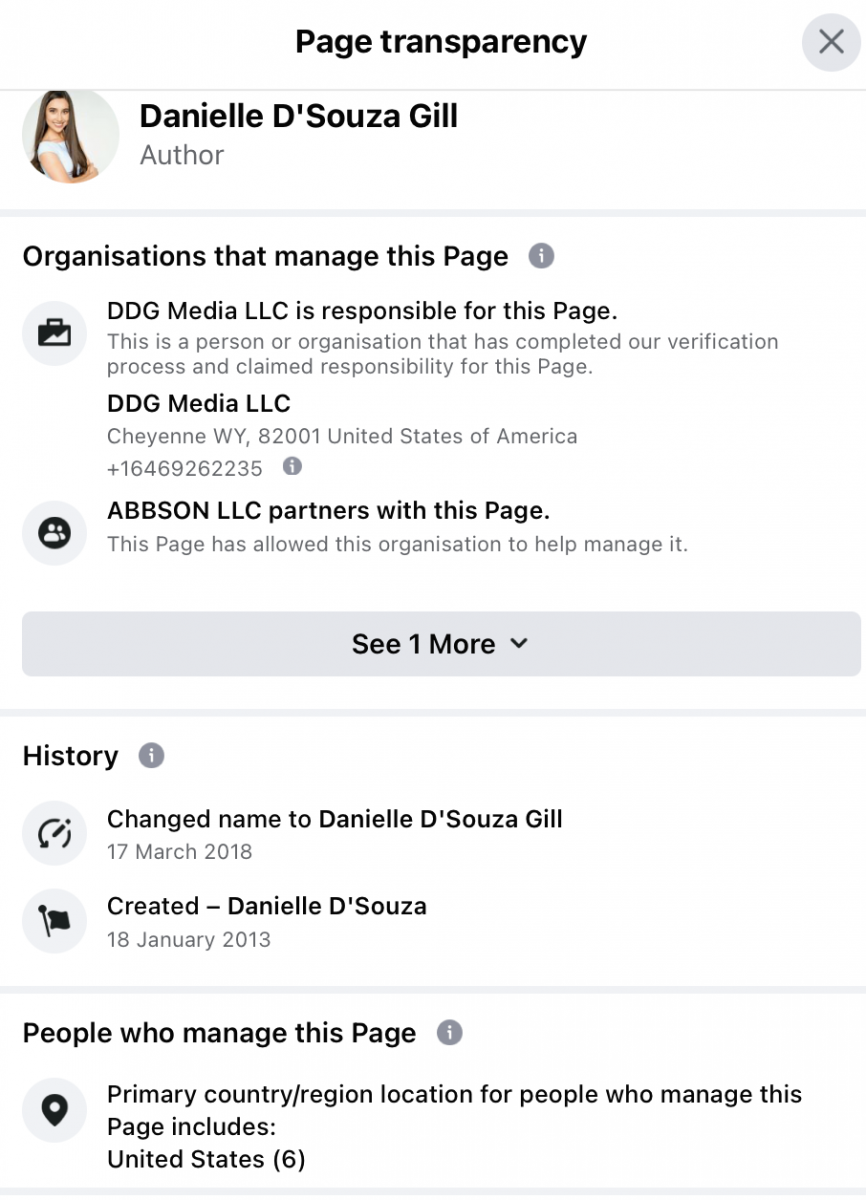
Page transparency section on Danielle D'Souza Gill's Facebook
To now start off, we show one of Gill's posts below. This fragment was collected on December 22nd, 2022.
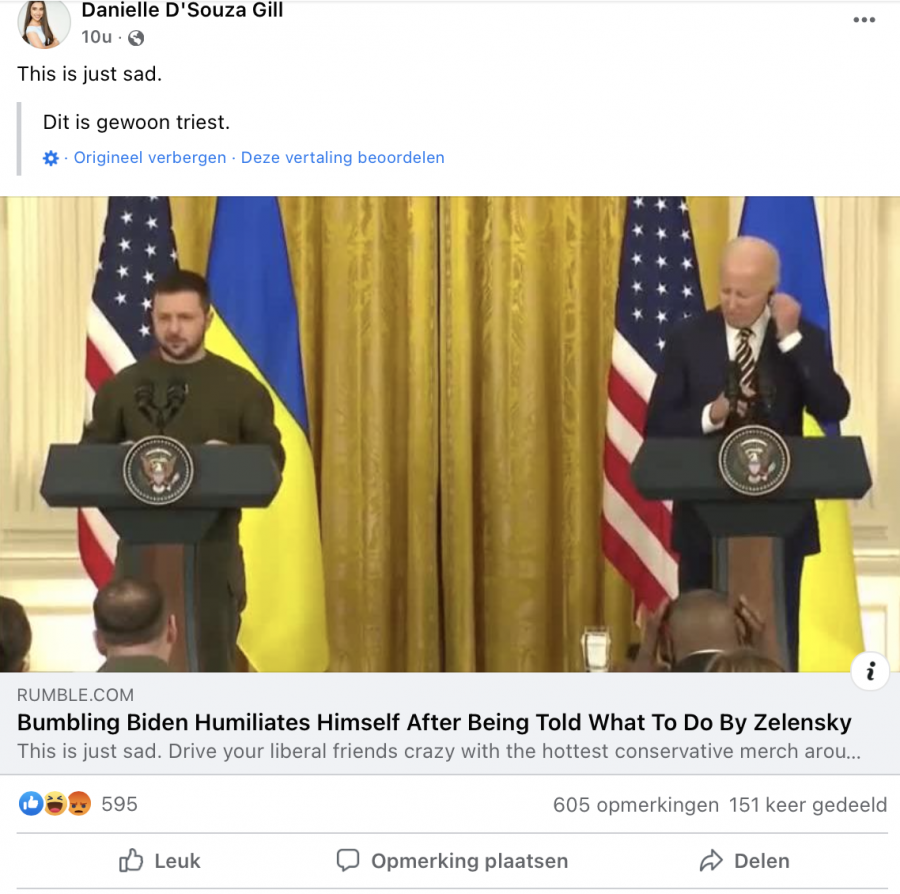
In this post, we see a link to a link to a short Rumble video of US President Biden reportedly being told to "put on the equipment" by Volodymir Zelensky. This is accompanied by the adage, "this is just sad". Here we see Gill use criticism of President Biden's competence and Ukraine policy that could easily be linked to other far-right discourses regarding such themes. However, in opening up this discussion, Gill does not interact with it overtly. Her statement is short and does not overtly contain any false news or conspiracy theories. In this manner, Gill can encourage the use of such discourses while avoiding moderation de-platforming. If we look at the comments under this post, as we will do in the next paragraph, we see that conspiracy theories regarding globalism among other far-right discourses that could be interpreted as fake news can be found here. Moreover, under the video thumbnail, we also see the text "This is just sad. Drive your liberal friends crazy with the hottest conservative merch around." This shows a means of monetizing far-right and conservative discourses. This all could link to a deeper influencer-like strategy that Gill uses. We discuss such things with more depth, in our article regarding Danielle D'Souza Gill's voice.
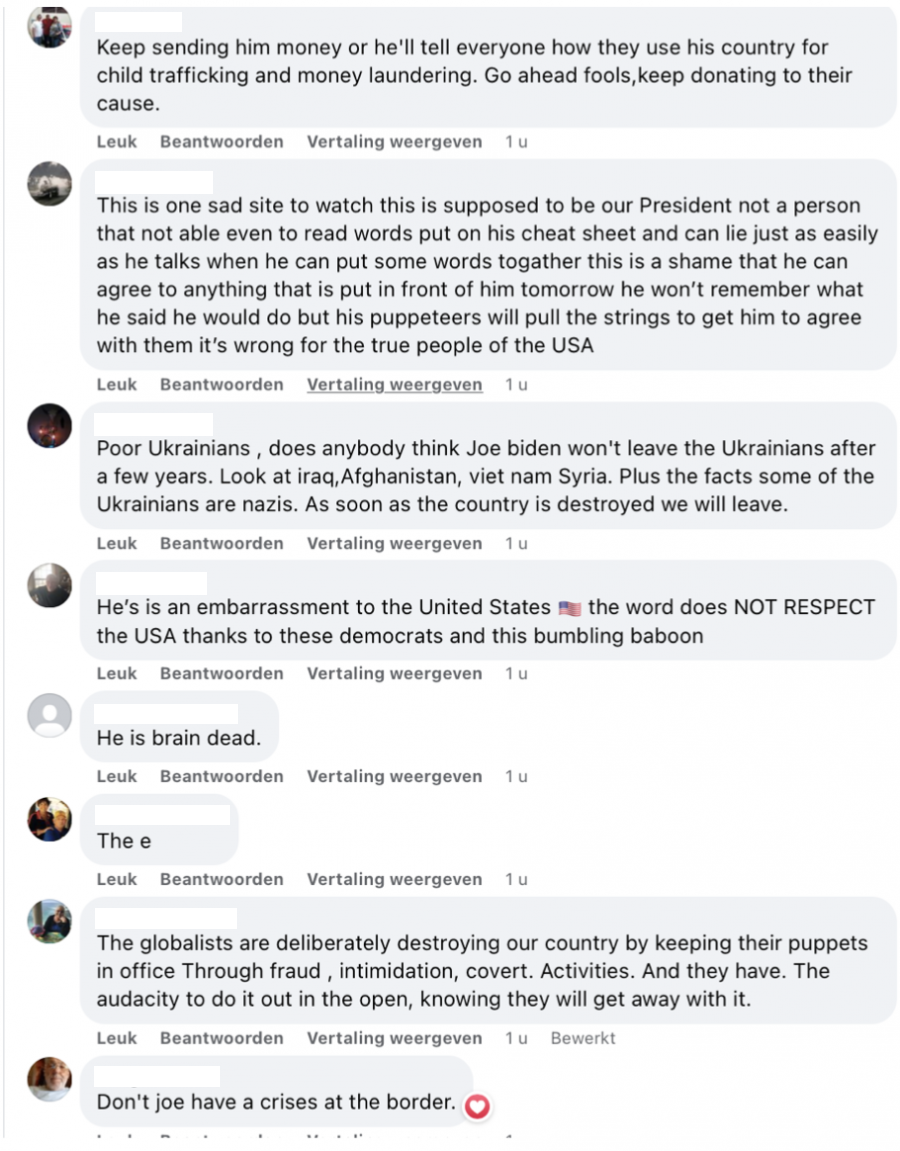
Comment section under Danielle D'Souza Gill post above
The post we have been discussing prompted 605 comments in ten hours. Many of these comments, like the ones above, engage with the subject of American aid for Ukraine during the ongoing war with Russia in that country. The top comment shows how this post is linked to the sending of money to Ukraine by the US. This is treated as negative. The second comment links this to Biden’s incompetence and illegitimacy. The second to last comment then attach this to conspiracy theories regarding globalists and the supposed deliberate destruction of the USA. This all shows how this singular post is linked to wider discourses popular on the far-right, such as President Biden’s illegitimacy and conspiracies regarding globalism. This is typical of many of the posts found during our research. Hence we see a sort of micro-hegemony building (Blommaert, 2005; Gramsci, 1971). A specific set of ideas is normalized and expressed.
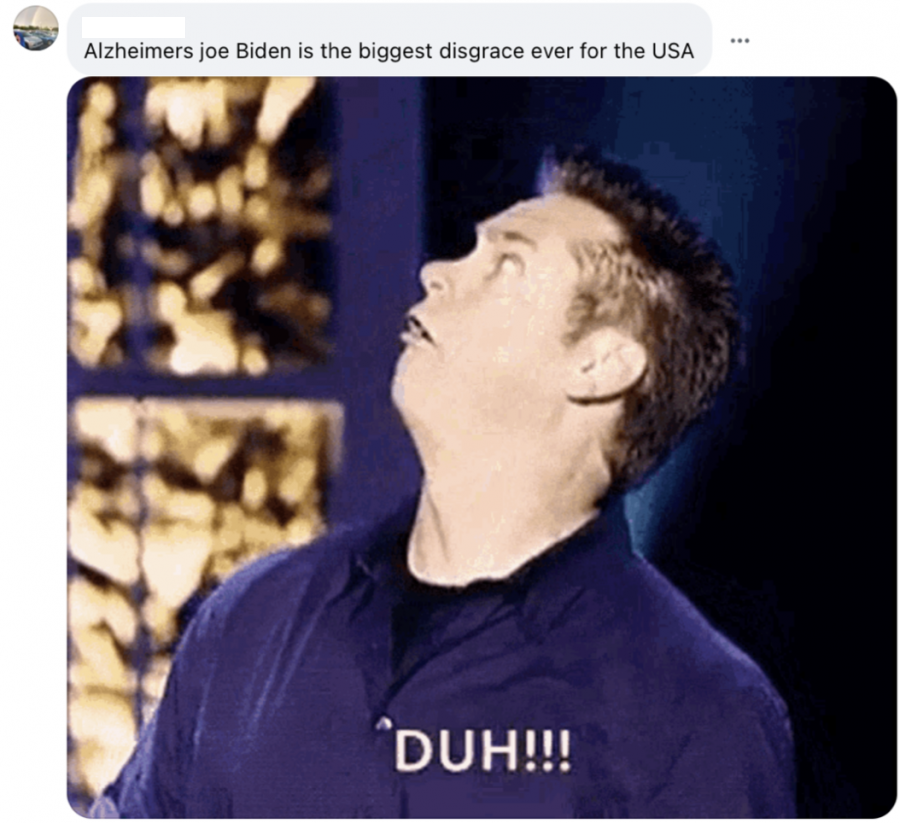
Meme type comment under Danielle D'Souza Gill's Facebook post
Such expressions can also take more ludic forms such as the meme comment that is posted above.
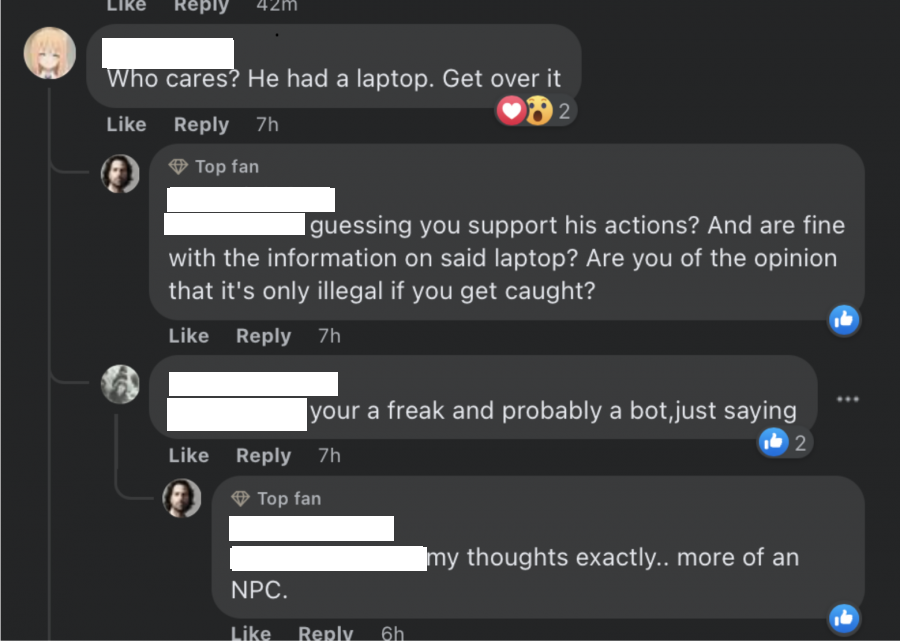
Panoptic structures visible in Danielle D'Souza Gill's comment section
In this screenshot made under the comment section of a post containing a podcast with Gill and Vish Burra concerning Hunter Biden’s “Laptop from Hell” we see that those who express disagreement with the idea that said laptop was a big deal are textually reprimanded by others. This commenter is even accused of being a bot. This type of social control indicates panoptic structures (Foucault, 1977), which supports the idea that a far-right micro-hegemony is built through engagement on Gill’s Facebook. The engagements between users, shown in the screenshot above, also support this.
Moreover, the user who actively shows such surveillance is a "top fan". This mechanic that rewards frequent engagement with a particular page, by denoting one as a "top fan" could be said to gamify engagement. As we saw such engagement can take the form of surveillance. We thus see how the gamification affordances of Facebook can be connected to the networked policing of critical voices in the case of Danielle D'Souza Gill's Facebook page.

Topfan comments that take the form of spam on Danielle D'Souza Gill's Facebook
However, we must place some limitations on this finding, due to the fact that we found many of the comments under Gill’s posts to be spam, as is visible above. They often contain repeated links and sales pitches. Many of these link to crypto-currencies in some manner. Additionally, a large volume of these comments is by “top fans” of Gill’s page.
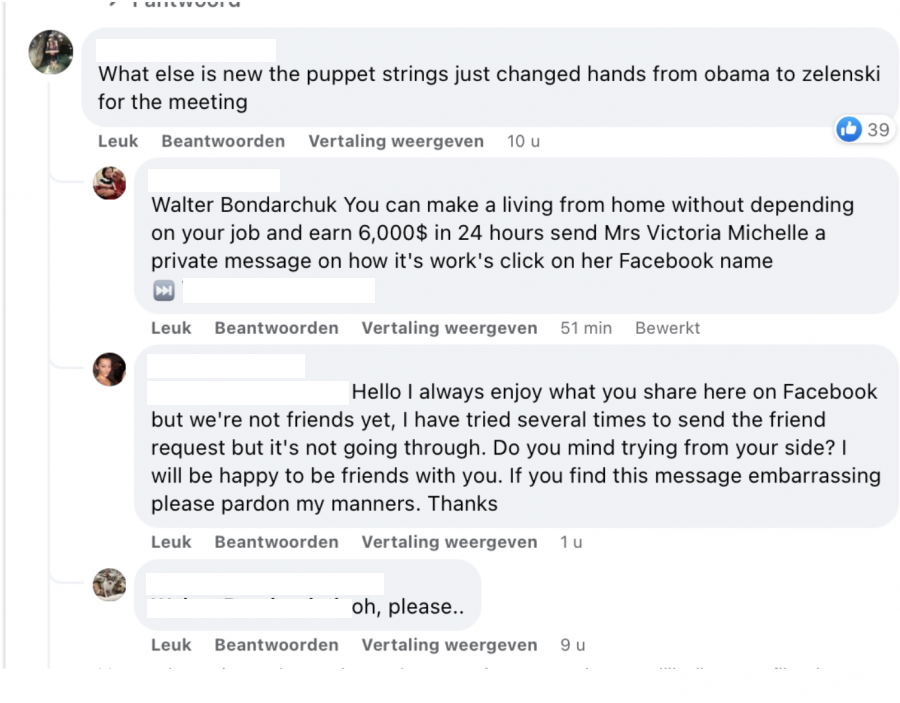
Spam responses to comments on Danielle D'Souza Gill's Facebook
We also found other types of spam. In the screenshot above, a commenter uses a script that was found verbatim over ten times under the same post by various users. Her Facebook account is almost completely empty as you can see below. In both cases of spam comments, we see little to no engagement with the post where these comments were placed.

Suspected bot account that commented on Danielle D'Souza Gill's Facebook
This all makes it difficult to assess how much engagement takes place on Gill’s Facebook account. Engagement seems to take place for some users. However, due to the high prevalence of spam comments, we cannot say how much of such engagement is real. It could be the case that spam is used to boost Gill’s engagement statistics, which could help her spread her message (Boichak et al, 2019; Lempert & Silverstein, 2012; Santini et al, 2020; Shoa, 2017). However, the spread of spam through Gill's account could negatively impact her reputation and future engagement (Claussen et al, 2013).
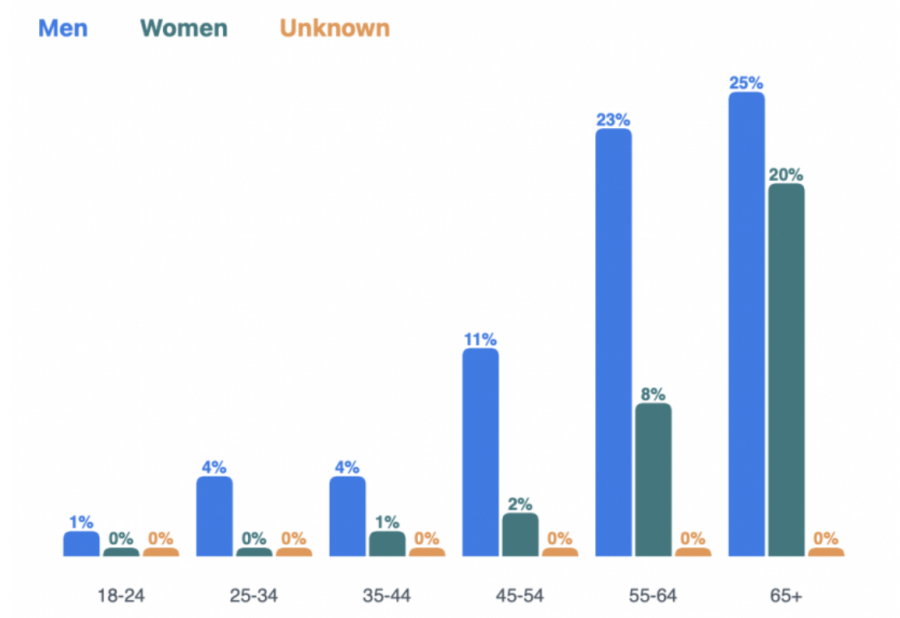
Demographics overview of latest Facebook advert posted by Danielle D'Souza Gill
Furthermore, we noted that a comparatively high number of elderly males engage with Gill's content. The demographics overview for users who engaged with Gill's latest Facebook advert as of Late January 2023 is shown above to illustrate this.
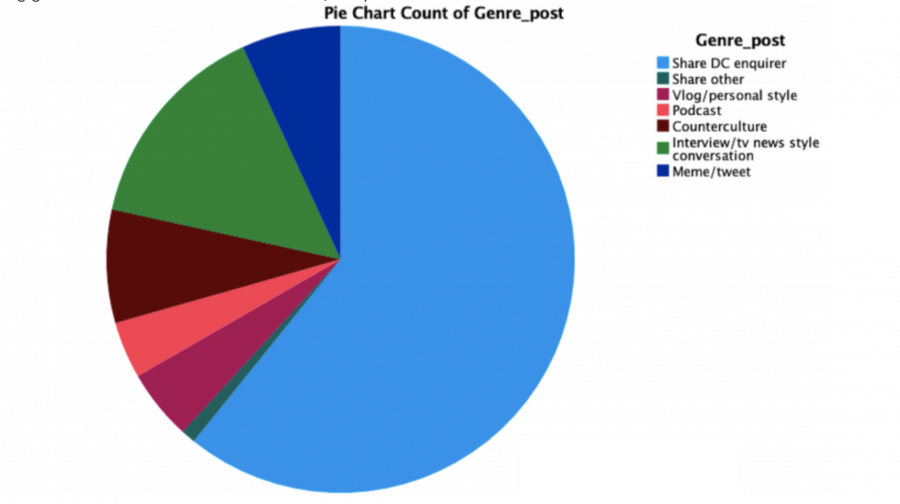
Piechart of different genre's of Facebook posts on Danielle D'Souza Gill's page in October 2022
Lastly, it was noted through an analysis of descriptives concerning the number of likes and comments per post in October 2022 that most of Gill’s posts linked to Gill’s Husband’s newspaper The DCenquirer. Many other posts also link to other far-right media sources such as podcasts and TV-style programming like Gill’s show Counterculture. As of late many of her posts link to the platform Rumble. This linking of various far-right platforms supports the idea that this page builds a far-right micro-hegemony by connecting various people and institutions (Blommaert, 2005).
Hence the frequent use of genres such as these further shows how Gill helps build a far-right micro hegemony
Moreover, outside of these posts containing literal links to other far-right institutions, many posts on Gill's page contain memes or screenshots of tweets. These again are both forms in which intertextuality is rather salient. This could be in part as the image format could help Gill evade moderation practices that could result in de-platforming. The humor element of such posts could also help Gill spread far-right discourses. Hence the frequent use of genres such as these further shows how Gill helps build a far-right micro hegemony. Let's now see how this is done in a different manner on Instagram.
Danielle D'Souza Gill's Instagram
For Instagram we do see similar micro-hegemony building practices, but with a more present personalization dimension. To start off, we must note that Gill's profile on Instagram is private. This means follower requests need to be approved by her or someone from her team to obtain access to her content. Hence, Gill controls who can be part of her audience. That could help her create her own niched media empire (Maly, 2020). Here we see a possible link to the fact that we found little to no cursing and other forms of offensive language on her account. This is somewhat unexpected given the controversial nature of her content. However, seemingly the fact that her account is private mitigates this.
Overall, the majority of her comments tended to be rather short. However, some longer ones were also noted. More controversial topics (e.g. abortion), seem to develop deeper discussion in the comment section.
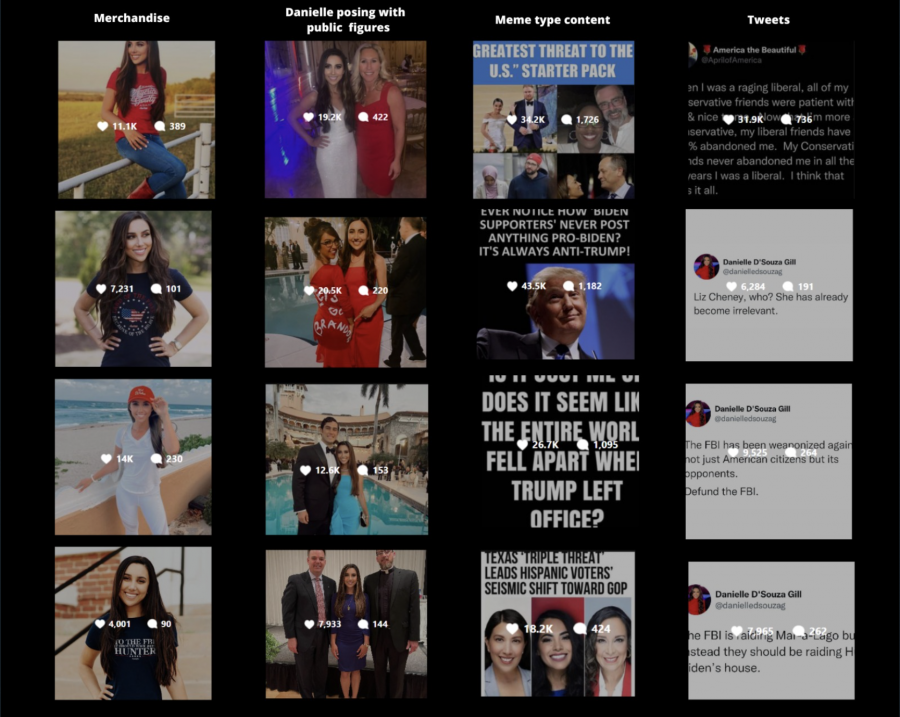
Amount of likes and comments that individual posts by Gill received

Average number of comments and likes that posts received per category(based on last four posts on 15-01-2023)
Despite or perhaps even because this account is private, rather high levels of engagement were noted through a significant number of likes and comments under each type of post. The amount, as well as the length of comments, varies. As shown in the table above, the number of comments and likes seems to be related to the type of content posted. There is quite a significant disparity between types of content.
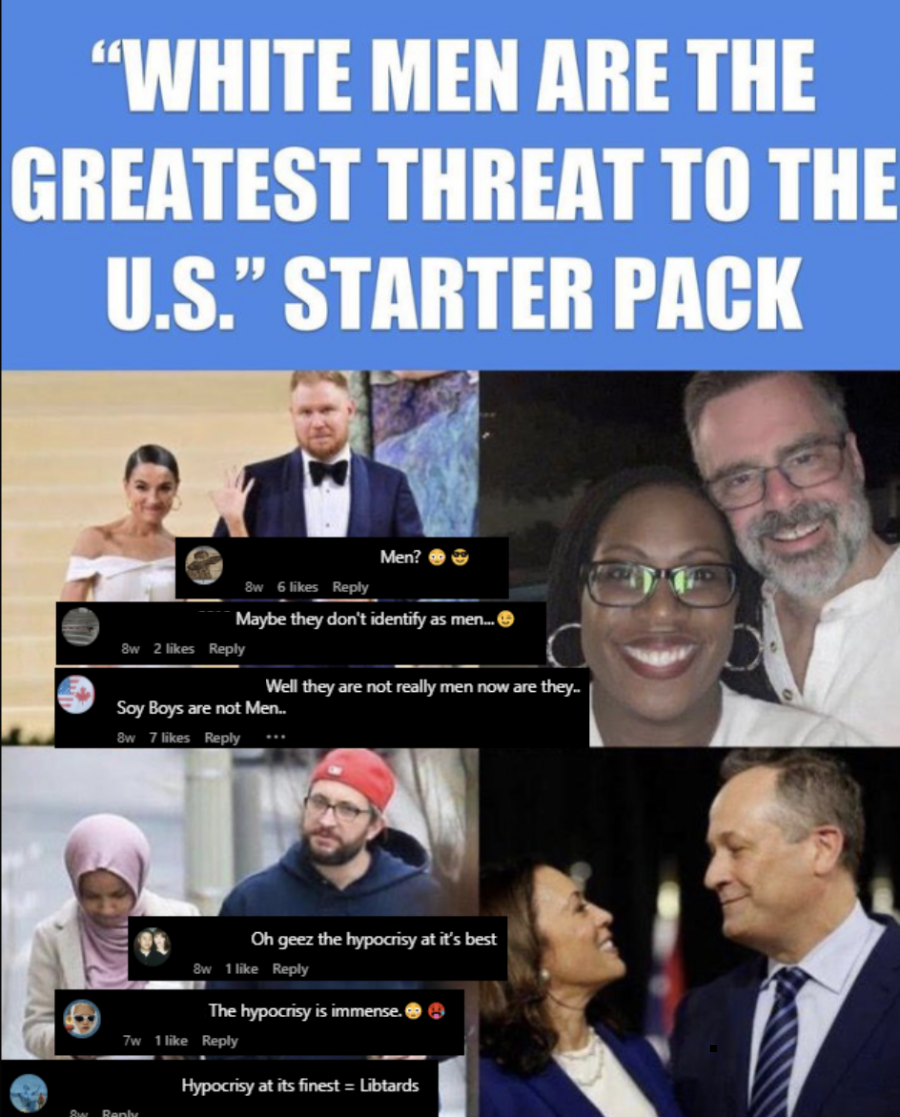
Example of meme-type post by Gill
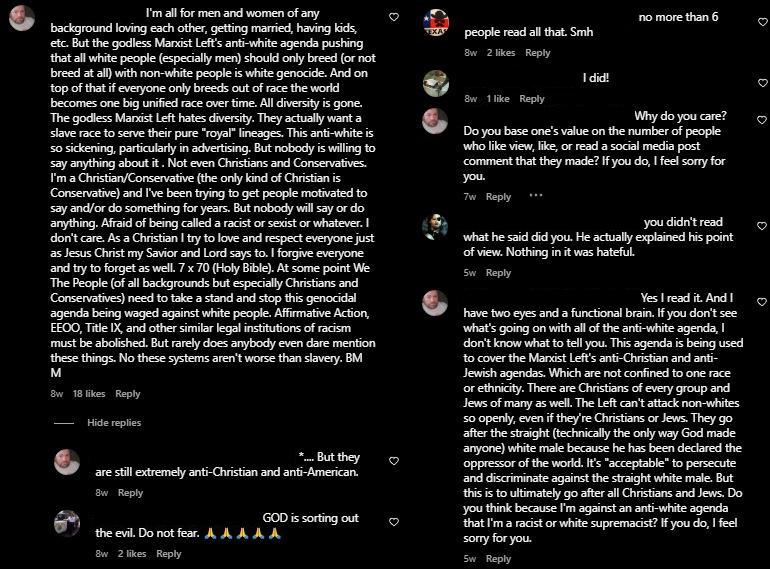
Example of comment section conversation under one of Gill's meme-like posts
In our dataset, meme format, which involved radical content, seemed to co-occur with quantitatively high levels of engagement from her followers. The reason behind the success of this content could be the fact that the humor attracts the audience together with strategic ambivalence. However, as presented above, most of these comments are rather short. The comments in the first image above for instance mock democratic politicians in a short manner. By doing so, agreement and engagement with the statement of the meme are shown. Nevertheless, longer comments could also be found. Here, users engage more deeply with the subject. For instance, as could be seen above, a user left a long comment, in which they shared their opinion. In this particular comment, Christian and Conservative values are indexed. The user has spoken on behalf of people with different backgrounds, which shows an attempt to convert people to his "truth". Some people seem to join the discourse and express either agreement or disagreement with the comment. This is visible through the number of likes on this comment and the various reactions to the comment that do express multiple opinions. This example shows how opinions are formed and shared through Gill’s Instagram. We do not only see the sharing of opinions but also reactions to those opinions. This could index further ideology and micro-hegemony building.

Another example of a meme-like post by Gill with comment section
Disagreement with Gill is rarely seen in the comment section. Nevertheless, it does sporadically occur. These kinds of comments often prompt many negative reactions. They are after all in the minority among the far-right Gill’s community. These comments seemingly are not removed as long as dissenting opinions are expressed “diplomatically”. However, as you can see above, dissent is surveilled and textually reprimanded similar to on Facebook (Foucault, 1977).
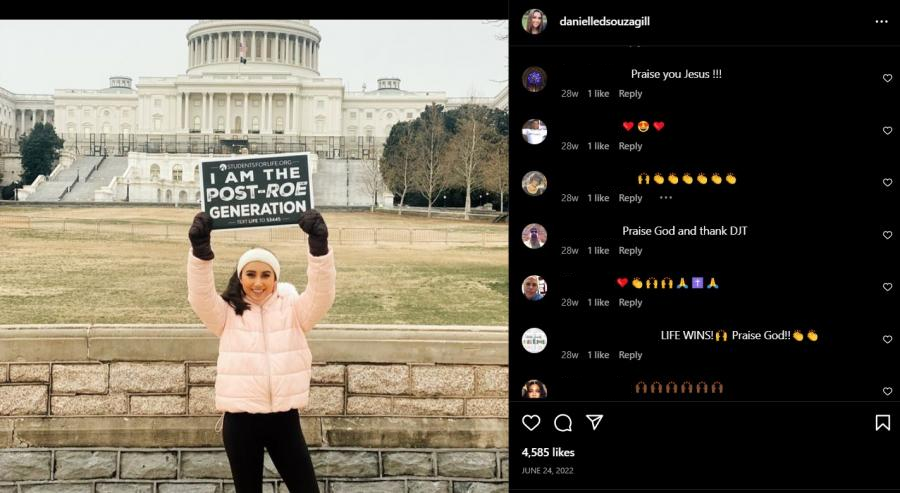
Further example of one of Gill's posts where her person is salient including comment section
Furthermore, we noticed a pattern of Christian-themed comments. The majority of such comments are placed under posts concerning her anti-abortion and pro-life movements. However, this is not the only place where such comments are found, as can be seen in the screenshot above of a post concerning a fan-merchandise t-shirt with the “Make America Godly again” slogan on it. People seem to express agreement with her words by shortly stating “amen”. Religion itself often being a mix between personal and political, we here see hints of Instagram’s often more personal style (Van Dijck, 2013).
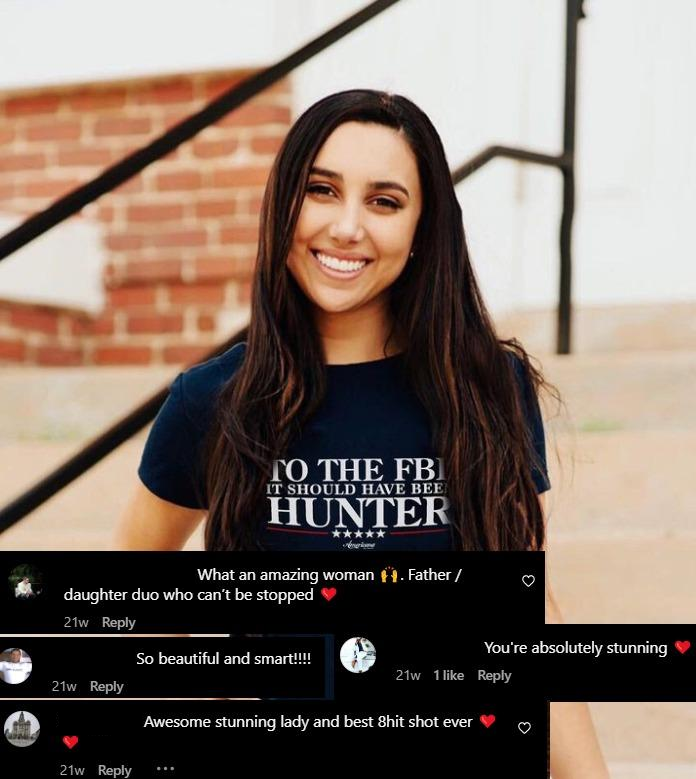
Further example of one of Gill's posts with comments that show personalization
These personalized aspects of comments on Gill’s Instagram are particularly salient in the large number of comments related to Gill as a person. Most of these concern her looks, activity, or her political persona. This aspect applies to the idea of Instagram’s affordances, where according to Hou (2019), influencers seek to gain the so-called staged authenticity by showing their private, more intimate side. This links to the higher presence of memes and other more overtly personal-style content.
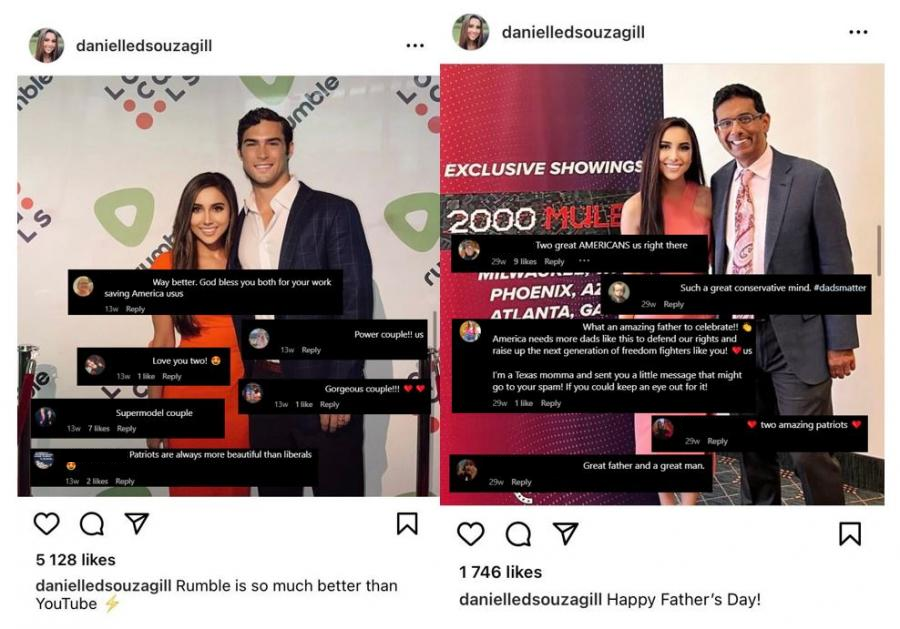
Examples of Gill showing of her family on Instagram with corresponding comments
Gill also makes her Instagram look more personal, by sharing photos of her husband, Brandon Gill, and her father, Dinesh D'Souza. Even though such content appears more personal, it is in a political context. It could be noted in the comment section on the post above that some commenters praise them for being a kind of “national heroes”. The comments above show not only engagement with Gill's person but also her family. This all shows how not only the content that Gill posts on Instagram are more personalized compared to other platforms but also that comments on this platform for Gill's content tend to relate more to specific persons, such as her family. We thus generally see a higher level of personalization on Instagram compared to Twitter and Facebook.
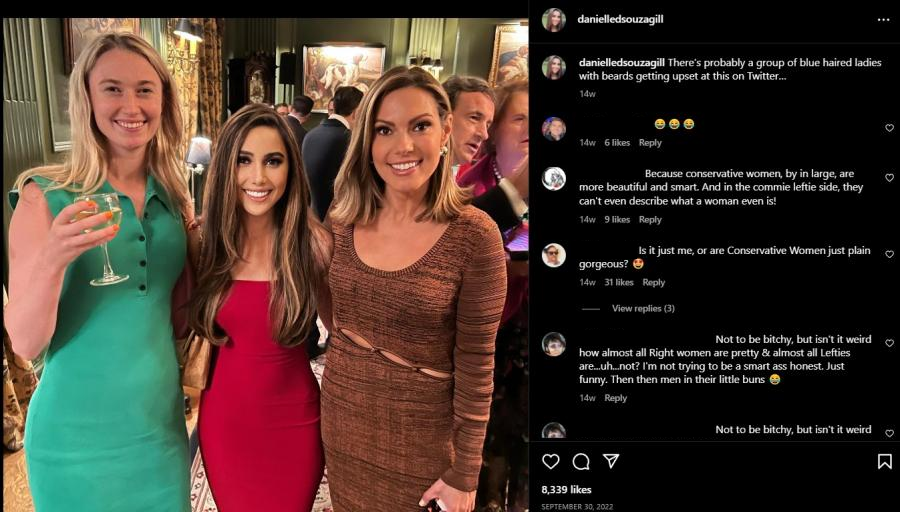
Example post by Gill on Instagram that seems to provoke broader discussion
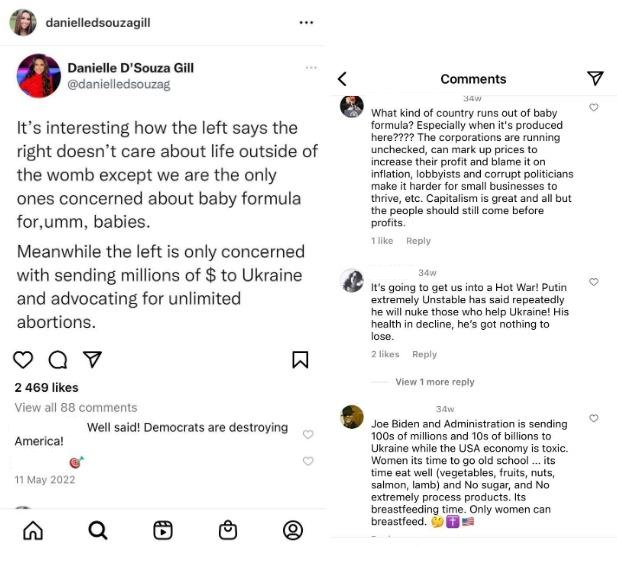
Further post by Gill on Instagram that seems to provoke discussion
It should also be noted that Gill's posts are often structured in a manner that invites engagement. As presented above, talking about “blue haired ladies with beards”, “lefties” and “war in the Ukraine” sparked a broader discussion in the comment section. It appears obvious that most of her followers agree with the presented statement, which shows the success of her metapolitical agenda via this platform.
Putting this all together, it can be concluded that micro-hegemony is built through the engagement with Gill’s Instagram profile in a rather personalized manner
Putting this all together, it can be concluded that micro-hegemony is built through the engagement with Gill’s Instagram profile in a rather personalized manner. Moreover, the expressions of religious belief that are to be found in comments under Gill’s posts here, could further index this blend of political and personal. After all, religion in itself can often be a mix of both (Adamczyk, 2008; Smart, 2008).
Limitations
Before moving on to the conclusion we will now address the limitations of this research. This article was researched during a limited time period, hence we can only speak to the manner in which uptake occurred in late 2022 and January 2023. Furthermore, that uptake was investigated through digital ethnography. This method does not allow us to speak to the mental states of subscribers/viewers and therefore does not allow us to say anything regarding how they feel about Gill’s content. Hence we attempted to report on how comments reflected and indicated uptake and engagement, but not as to how well people were convinced of specific arguments by Gill. This all means no hard causality is implied between Gill’s content and one’s beliefs. Such a relationship might exist and is definitely of interest, but falls outside the scope of this article. Through this article, we only attempt to show how comments show different patterns of engagement that indicate the building of far-right micro-hegemony. The differences between these patterns on other platforms are what we focussed on.
The difference in uptake
In analyzing the uptake of Gill’s content on the platforms of Twitter, Facebook, and Instagram we noted a couple of crucial differences.
Primarily, the uptake seems thicker on Facebook and Instagram compared to Twitter. The affordances of Twitter do not allow for high levels of visible engagement due to the character limit of this platform. High levels of uptake could have taken place on Twitter, but they were not found in this study. Hence the building of a far-right micro-hegemony is far less visible in the uptake of Gill’s content on Twitter compared to Facebook and Instagram. This could help explain her relative inactivity on the platform. Even so, other factors such as the perceived partiality of Twitter might also play a role here. With the recent acquisition of Twitter by Elon Musk and the uncertain state of the platform this is certainly a thing to keep an eye on for future developments. Furthermore, we also found that the uptake on Instagram is somewhat more personalized compared to Facebook and Twitter. Comments regarding her person seem more common. This could also link to the affordances of Instagram. Her account on the said platform is private which might also aid this. We can thus say that platform is an important factor in how uptake takes place for Gill.
We can thus say that platform is an important factor in how uptake takes place for Gill
This all supports the idea that platforms act as mediators rather than intermediaries (Van Dijck, 2013). They affect how uptake and engagement of/with content are affected by the affordances and limitations of the platform that this is taking place on. This article has shown how this takes place in the particular context of the far-right influencer Danielle D’Souza Gill. Given the professionalism of Gill’s accounts this likely also shows how such aspects of socio-technological platforms can be utilized to reach specific goals such as building a particular audience, micro-hegemony, and creating financial gain. Ico Maly’s (2020) article regarding Britanny Pettibone shows how another far-right influencer does so. Even so, we cannot conclude fully about the intentions behind specific acts given our method. For such findings to be supported, an interview or similar inquiry would need to be performed.
Therefore we recommend further inquiry into how digital platforms’ affordances can be/are used to further ideological goals, specifically on the far-right. As a small starting example of how this could look, we attempted to deal more directly with how Gill uses her voice in another article in this file.
References:
Blommaert, J. (2005). Discourse: A critical introduction. Cambridge University Press.
Geyser, W. (2023). What is an Influencer? – Social Media Influencers Defined [Updated 2023].
Vogt, W., Gardner, D . Haeffele, L. (2012). When to use what research design. Guilford Press.